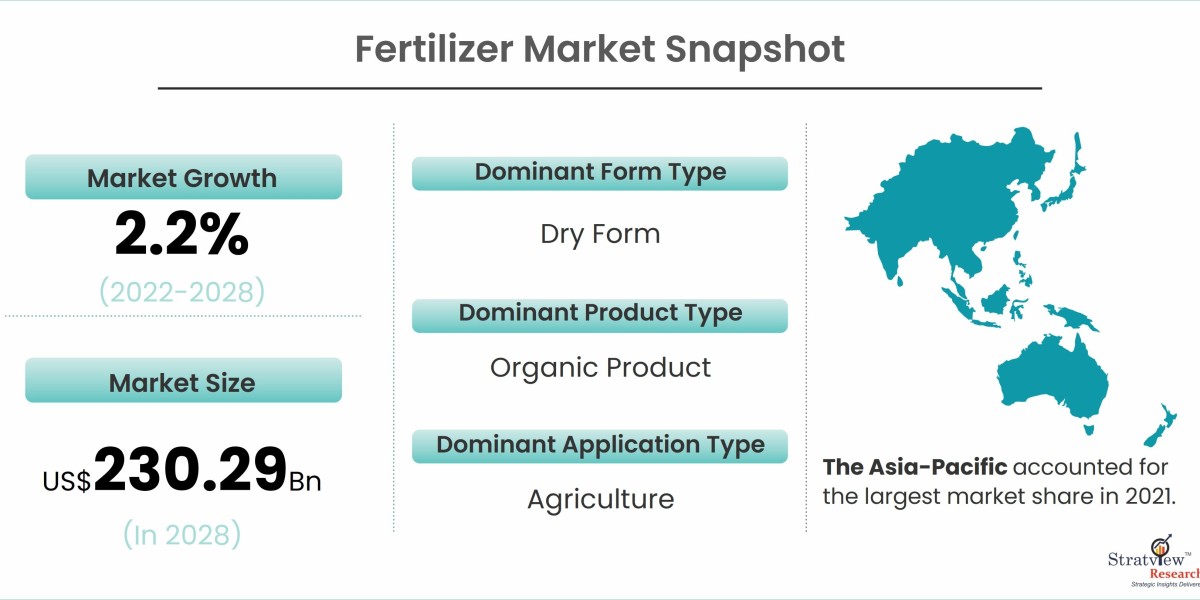Fertilizers are a cornerstone of modern agriculture, playing a pivotal role in boosting crop yields and ensuring food security for a growing global population. However, the rising costs of fertilizers have put significant pressure on farmers' budgets. In this article, we'll explore the economics of fertilizer use and provide practical, cost-effective strategies for farmers to optimize their fertilizer investment.
According to Stratview Research, the Global Fertilizer Market is estimated to grow from USD 197.75 Billion in 2021 to reach USD 230.29 Billion by 2028 at a healthy CAGR of 2.2% during the forecast period of 2022-2028.
Fertilizer is a type of chemical or natural substance added to soil or land to increase its fertility, i.e. to increase its ability to support plant growth. Fertilizers can be natural or synthetic, and they can contain a variety of nutrients, including nitrogen, phosphorus, potassium, and micronutrients.
To read more about the report, click here:
https://www.stratviewresearch.com/1388/fertilizer-market.html
Understanding the Cost Components
Before delving into strategies, it's essential to grasp the various cost components associated with fertilizers:
1. Raw Material Costs: The prices of key raw materials, such as nitrogen, phosphorus, and potassium, directly impact the overall cost of fertilizers. These costs are subject to market fluctuations influenced by factors like energy prices, global demand, and geopolitical events.
2. Transportation and Distribution: Transportation expenses can be a significant portion of the overall cost of fertilizers. Factors like distance, mode of transportation, and fuel prices play a role in determining these costs.
3. Application Costs: The method of application, whether broadcast, precision, or foliar, can influence the labor, equipment, and fuel expenses associated with fertilization.
Strategies for Cost-Effective Fertilizer Use
Given these cost components, here are some strategies that farmers can employ to make the most of their fertilizer investments:
1. Soil Testing and Nutrient Analysis: Before applying any fertilizer, it's crucial to conduct thorough soil testing. This provides valuable insights into the nutrient levels and pH of the soil. By understanding the specific needs of their fields, farmers can avoid over-application and target the nutrients that are truly required.
2. Balanced Fertilization: A balanced approach to fertilization involves ensuring that the essential nutrients (nitrogen, phosphorus, and potassium) are applied in the right proportions. Over-reliance on a single nutrient can lead to imbalances and inefficient use of resources.
3. Variable Rate Application (VRA): Utilizing technology like GPS-guided machinery allows for variable rate application, where fertilizers are applied in varying amounts across a field based on the specific needs of different areas. This precision approach maximizes nutrient utilization and minimizes wastage.
4. Incorporate Organic Matter: Integrating organic matter through practices like cover cropping, composting, and crop residue management can enhance soil fertility. Organic matter serves as a natural source of nutrients, reducing the reliance on synthetic fertilizers.
5. Utilize Crop Rotation: Crop rotation is an age-old practice with significant benefits. Different crops have varying nutrient requirements, and rotating them can help break pest and disease cycles while optimizing nutrient use.
6. Explore Alternative Fertilizer Sources: Farmers can investigate alternative, cost-effective sources of nutrients. This may include utilizing manure, and biosolids, or exploring local sources of organic matter.
7. Consider Slow-Release Fertilizers: Slow-release fertilizers deliver nutrients to plants over an extended period, reducing the risk of leaching and runoff. While they may have a higher upfront cost, they often prove more cost-effective over the long term.
8. Monitor and Evaluate: Regularly monitoring crop health and growth patterns, along with conducting follow-up soil tests, allows farmers to make adjustments to their fertilizer strategies as needed. This adaptive approach ensures that resources are allocated efficiently.
Conclusion
The economics of fertilizer use in agriculture are complex, but with strategic planning and implementation, farmers can optimize their fertilizer investments. By incorporating practices like soil testing, balanced fertilization, and precision application, farmers can achieve higher yields and improve their bottom line. Moreover, adopting sustainable and cost-effective fertilizer strategies contributes to the long-term health of soils and promotes environmentally responsible agricultural practices. With these strategies in hand, farmers can navigate the challenges of rising fertilizer costs while ensuring the continued productivity and sustainability of their operations.
About Us
Stratview Research is a global market research firm, offering syndicated and custom research reports along with growth consulting services. Our business intelligence and industry research reports offer clients insightful market data to aid strategic decision-making. These exclusive reports are the result of exclusive research methodology and are available for key industries such as chemicals, composites, advanced materials, technology, renewable energy, and more.
Stratview Research delivers custom research services across sectors. In case of any custom research requirements, please send your inquiry to sales@stratviewresearch.com or connect with our experts at +1-313-307-4176.








